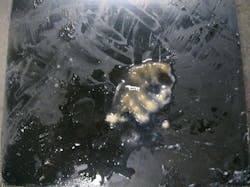The Blame for Biofouling
Biofouling, also known as biological fouling or biological contamination, is the process in which biofilms accumulate on reverse osmosis (RO) membranes, degrading membrane performance and preventing the system from operating at optimal efficiency. A number of factors have been identified as playing a role in biofouling, but recent research revealed a previously unidentified potential cause: elastomeric materials such as gaskets and O-rings.
Harboring the Microorganisms
RO and other membrane filtration systems provide optimum moisture, pH and temperature conditions for microorganism colonization. The surface colonization develops into a biofilm if propagation of microorganisms is supported by organic nutrients. Although the goal of pretreatment is to remove such substances, microorganisms can multiply. Thus, even if 99.9% are removed, enough cells will remain in the system to grow.
In many cases, RO plants incur downtime and increased costs as a result of biofouling. The biofilm slows the flow of water at standard operating pressures, so system pressure may need to be increased to maintain recovery rates. This requires more energy, leading to higher operating costs. The higher pressure exerted on system components may damage the equipment, and the membranes may need to be cleaned or changed more frequently.
Various factors have been determined as playing a role in the severity of biofouling, among them: feedstock quality, presence of organic and inorganic nutrients, temperature, pH, dissolved oxygen concentrations, membrane type, and chemicals used in the water.
Elastomeric materials, which can leach organic substances into the water and support the growth of microorganisms, can be added to that list. Used in a wide variety of water applications, gaskets and O-rings typically are associated with mechanical pipe joining methods. Grooved couplings—of which the gasket is a key component—are used within membrane filtration systems to connect the header pipe to the pressure vessels because they provide joint flexibility and ease membrane maintenance and replacement procedures. Chemicals such as chlorine cannot be added at this point in the filtration process because they can cause membrane deterioration.
Although not previously studied in the RO industry, the fact that elastomeric materials provide a source of nutrients for microorganisms is not new to water chemists and microbiologists. In fact, countries such as the U.K., Germany and China have introduced compulsory tests for microbiological resistance of all elastomeric materials used in contact with drinking water. Despite these emerging national standards and regulations, there still are many commercially available ethylene propylene diene monomer (EPDM) compounds used in clean water applications that contain plasticizers and processing aids, which promote propagation of microorganisms on contact with either chlorinated or non-chlorinated water.
Evaluating Resistance
Victaulic, a manufacturer of mechanical pipe joining systems, undertook a research project to evaluate the microbiological resistance of new and commercially available compounds. The goal was to identify ingredients in rubber formulations that do not support microbial growth, and develop a “clean” compound based on those ingredients. The test methods used—developed by drinking water agencies in the aforementioned countries—were biomass volume, mean dissolved oxygen difference and chemical oxygen demand.
In the biomass volume test, rubber test plates were inserted in a 100-liter stainless steel tank with a continuous flow of water. Local tap water entered the tank where the flow rate was maintained at 20 liters per hour. The samples were totally submerged in water at ambient and positioned by hangers so that the surfaces did not touch one another. Plates made of microbiologically inert glass material were used as negative controls, and glass plates coated with paraffin were used as positive controls. Two plates were required for each test material.
The test container was covered and the test plates were removed every four weeks throughout the 12-week test period. At each test interval, biomass that formed on the rubber plates was scraped and transferred into a centrifuge tube. The biomass sample was centrifuged for 10 minutes at 3,000 xg, and the volume of the centrifuged biomass in milliliters was read from the scale on the centrifuge tube, comparatively indicating microbiological resistance of the compound. The one-day chemical oxygen demand and six-week mean dissolved oxygen difference tests provided supporting data.
Researchers found that the commercial compounds were the least resistant to microbiological growth. Antimicrobial agents incorporated in the compound did not provide efficient protection against the development of biofilms. Attention was therefore paid to the selection of compounding ingredients and processing conditions. Few ingredients were identified with little or no biomass formation, which enabled the researchers to optimize a compound using those ingredients. The reformulated EPDM gasket material combined with special processing can reduce biofilm formation 75 times more effectively than commercial elastomeric seal materials can.
Applying the Research
A number of factors contribute to biofouling, but replacing old gaskets with new ones made of clean rubber compounds can virtually remove the gasket as a factor. This could be completed during a planned shutdown, and is certainly something a plant with an ongoing biofouling problem might want to consider. Of course, other actions still will need to be taken, such as ensuring the pretreatment pumps are operating efficiently, chemicals are being dosed accurately, and the plant is laid up properly during a shutdown.
The results of the research showed that the careful selection of wetted system components, including elastomeric materials, is an important step in reducing microbial growth and associated biofouling to maintain the efficiency of membrane filtration systems.
Download: Here
